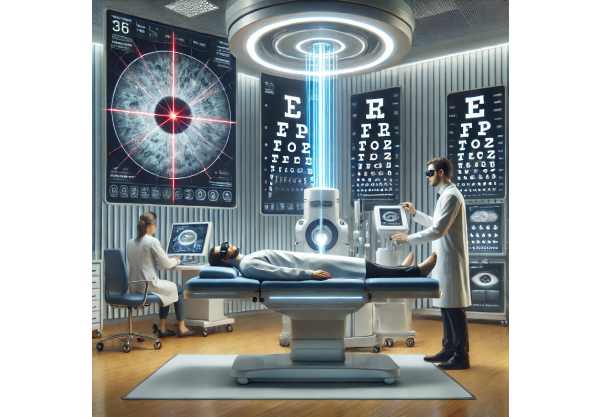
Central Retinal Artery Occlusion (CRAO) is a vision-threatening emergency that results from a blockage of the main artery supplying blood to the retina. Most often affecting adults over the age of 50, this condition can cause sudden, painless vision loss in one eye and is considered the ocular equivalent of a stroke. Immediate recognition and intervention are vital for optimizing visual outcomes and reducing the risk of future vascular events. This comprehensive guide explores the underlying causes, presents evidence-based treatments, details surgical options, and introduces the latest innovations in CRAO management.
Table of Contents
- Cracking the Code: Understanding and Prevalence
- Conservative Measures and Pharmacological Support
- Surgical Interventions and Procedural Advances
- Innovative Technologies and Therapeutic Frontiers
- Current Clinical Trials and Future Directions
- Frequently Asked Questions
Cracking the Code: Understanding and Prevalence
Central Retinal Artery Occlusion (CRAO) arises when the central retinal artery, responsible for supplying oxygen and nutrients to the inner retina, becomes suddenly obstructed—typically by an embolus (blood clot), plaque, or arteritis. Without prompt restoration of blood flow, retinal cells quickly suffer irreversible damage, often within 90–120 minutes.
Definition & Pathophysiology:
- CRAO is an ophthalmic emergency causing acute, painless, monocular vision loss.
- Most blockages are embolic (cholesterol, platelet-fibrin, or calcific).
- Less commonly, inflammatory causes such as giant cell arteritis are responsible, especially in older adults.
Prevalence & Demographics:
- Incidence: Approximately 1–2 per 100,000 people annually.
- Most common in adults over 60, with a slight male predominance.
- Risk increases with cardiovascular risk factors: hypertension, diabetes, hyperlipidemia, atrial fibrillation, and carotid artery disease.
Risk Factors:
- Atherosclerosis and cardiac valvular disease
- Smoking
- Hypercoagulable states (e.g., clotting disorders)
- Migraine or vascular spasm
- Giant cell arteritis (in patients over 50, especially women)
Clinical Presentation:
- Sudden, profound vision loss in one eye, often described as a “curtain” falling.
- Relative afferent pupillary defect (RAPD) on examination.
- Cherry-red spot in the macula with retinal whitening is classic on fundus exam.
Practical Advice:
Anyone experiencing sudden vision loss should seek emergency care immediately, as timely intervention is essential to preserving vision and assessing underlying systemic risks.
Conservative Measures and Pharmacological Support
The management of CRAO is highly time-sensitive. There is currently no universally accepted medical therapy proven to restore vision reliably, but several strategies may be attempted within the critical early hours after symptom onset.
Initial Emergency Steps:
- Immediate Ocular Massage: Gently applying and releasing pressure to the eye in an attempt to dislodge the embolus.
- Reduction of Intraocular Pressure (IOP): Using topical medications (beta-blockers, alpha agonists), intravenous acetazolamide, or paracentesis to lower eye pressure and encourage arterial perfusion.
- Breathing into a Paper Bag: Briefly increasing carbon dioxide may cause retinal vessel dilation, potentially moving the blockage.
- Hyperbaric Oxygen Therapy: Delivers high concentrations of oxygen to the retina, though availability is limited and efficacy is still under investigation.
Pharmacological Agents:
- Antiplatelet and Anticoagulant Therapy: Aspirin, heparin, or newer agents may be considered, especially if a clotting disorder is suspected.
- Thrombolytics: Intra-arterial or intravenous thrombolysis (e.g., tPA) has been studied, with best results when administered within 4–6 hours of vision loss—though risks and benefits are debated.
- Steroids: In cases caused by giant cell arteritis, high-dose corticosteroids are mandatory to prevent vision loss in the other eye.
Supportive Care:
- Systemic Workup: Evaluate for underlying vascular risk factors—blood pressure, blood sugar, cholesterol, carotid ultrasound, cardiac echocardiogram, and coagulopathy panels.
Patient Monitoring and Follow-Up:
- Arrange close ophthalmology and neurology follow-up for stroke risk assessment and secondary prevention.
Practical Advice:
Although vision restoration is often limited, controlling cardiovascular risk factors and following your doctor’s advice reduces your risk of future strokes and vision loss in the other eye.
Surgical Interventions and Procedural Advances
While no standardized surgical treatment has been definitively proven for CRAO, several interventional techniques are under study and may be considered in select, acute cases.
Key Surgical and Interventional Strategies:
- Anterior Chamber Paracentesis: Needle aspiration of aqueous fluid to rapidly lower IOP, potentially improving retinal perfusion.
- Intra-Arterial Thrombolysis: Direct catheter-based administration of clot-busting drugs into the ophthalmic artery. This technique is available at some specialized centers and shows best results when initiated very early.
- Laser Embolectomy: Rarely, lasers can be used to break up visible emboli in the retinal artery, though this is experimental.
Adjunctive Treatments:
- Carbogen Inhalation: Mixture of carbon dioxide and oxygen to dilate retinal vessels, though evidence for benefit is limited.
- Hyperbaric Oxygen: Used as a supportive adjunct, may improve oxygenation if started within 24 hours.
Minimally Invasive Techniques:
- Advances in catheter-directed therapy, imaging, and real-time visualization have enabled safer and more targeted approaches.
- Intraocular surgeries are generally reserved for associated complications, such as neovascular glaucoma.
Prevention of Complications:
- Monitor for neovascularization (new, abnormal blood vessels) and secondary glaucoma, which may require laser or surgical intervention.
Practical Advice:
If you are at a specialty center, ask about the availability and suitability of acute interventions such as thrombolysis or hyperbaric oxygen. Early treatment is crucial for even a chance of vision recovery.
Innovative Technologies and Therapeutic Frontiers
The future of CRAO management lies in more rapid diagnosis, novel therapies, and neuroprotective approaches.
Emerging Therapies:
- Neuroprotective Agents: New drugs aimed at protecting retinal ganglion cells during acute ischemia are in preclinical and early clinical trials.
- Gene Therapy: Research is ongoing to develop gene-editing or delivery methods that could protect or repair ischemic retinal tissue.
- Stem Cell Therapy: Early-stage investigations are exploring whether stem cell injections can restore some degree of retinal function after CRAO.
Advanced Diagnostics:
- Ocular Imaging: High-resolution OCT angiography allows earlier and more precise identification of retinal ischemia and monitoring of reperfusion.
- AI-Based Risk Stratification: Artificial intelligence algorithms are being used to predict which patients are at greatest risk and to support acute decision-making.
Telemedicine and Rapid Response:
- Mobile apps and teleophthalmology programs facilitate early recognition and triage for patients, improving chances of urgent intervention.
Practical Advice:
Stay informed about innovative clinical studies and emerging treatments—especially if you have significant risk factors for vascular disease. Participation in research can open doors to new therapies.
Current Clinical Trials and Future Directions
With vision recovery rates remaining low, there is a strong drive for research into both acute interventions and preventive strategies.
Active Research Focus:
- Acute Thrombolysis Trials: Multi-center studies are evaluating the safety and efficacy of tPA and other clot-dissolving agents within narrow time windows.
- Neuroprotection Trials: Investigating agents that might limit permanent retinal damage if administered quickly.
- Novel Oxygen Delivery: Devices and new protocols for oxygen supplementation or hyperbaric therapy.
Preventive Strategies:
- Studies are assessing optimal systemic risk reduction to prevent CRAO recurrence and associated strokes.
- New blood thinners and anti-platelet medications are being evaluated for long-term protection.
Patient Enrollment and Support:
- Clinical trial participation may offer access to state-of-the-art care.
- National registries are collecting data to help identify the most effective interventions and inform evidence-based guidelines.
Looking Ahead:
- Integration of AI, digital health, and rapid diagnostics promises to reduce delays in CRAO management.
- Improved patient education and healthcare system readiness are critical for better outcomes.
Practical Advice:
If you or a loved one has CRAO, ask your healthcare provider about available trials and the latest research. Continued engagement helps advance the field and may provide direct benefit.
Frequently Asked Questions
What is the main cause of central retinal artery occlusion?
The main cause of CRAO is a blockage of the central retinal artery, often by a cholesterol or blood clot (embolus) traveling from the heart or carotid arteries.
Can vision loss from CRAO be reversed?
Vision recovery is rare and depends on how quickly treatment is started—ideally within hours. Most patients have permanent vision loss, but some may regain partial sight with immediate care.
What is the best immediate treatment for CRAO?
Urgent ocular massage, lowering intraocular pressure, and evaluation for possible thrombolytic therapy are the best immediate interventions. Time is critical for any chance of visual recovery.
Is CRAO a sign of a stroke risk?
Yes, CRAO is closely associated with an increased risk of stroke and other vascular events. Comprehensive medical evaluation and prevention strategies are essential.
Are there any new treatments for central retinal artery occlusion?
Clinical trials are investigating new drugs, gene therapy, and advanced thrombolytic procedures, but standard therapies are limited and most promising treatments are still under research.
Who is at risk for CRAO?
People with cardiovascular risk factors—high blood pressure, diabetes, high cholesterol, smoking, or a history of vascular disease—are at increased risk for CRAO.
Disclaimer:
This content is intended for educational purposes only and should not replace professional medical advice, diagnosis, or treatment. For any sudden vision loss or related symptoms, consult a qualified healthcare provider immediately.
If you found this article helpful, please share it on Facebook, X (formerly Twitter), or your preferred platform, and follow us on social media. Your support enables us to continue producing high-quality, accessible health content. Thank you!










